(完整版)初中英语从句知识点总结归纳.doc
初中英语定语从句知识点总结
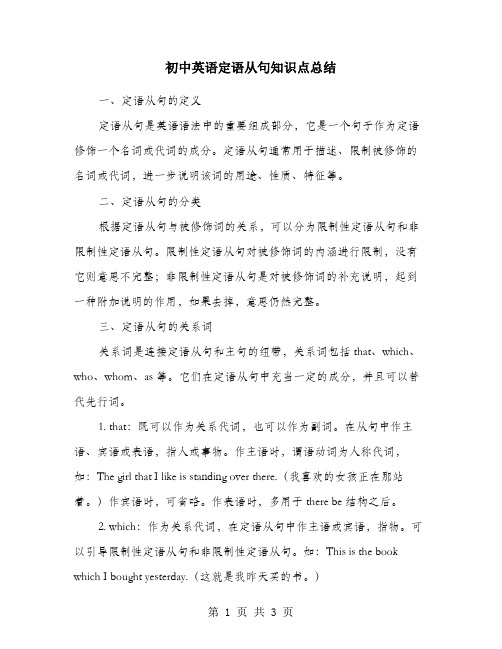
初中英语定语从句知识点总结一、定语从句的定义定语从句是英语语法中的重要组成部分,它是一个句子作为定语修饰一个名词或代词的成分。
定语从句通常用于描述、限制被修饰的名词或代词,进一步说明该词的用途、性质、特征等。
二、定语从句的分类根据定语从句与被修饰词的关系,可以分为限制性定语从句和非限制性定语从句。
限制性定语从句对被修饰词的内涵进行限制,没有它则意思不完整;非限制性定语从句是对被修饰词的补充说明,起到一种附加说明的作用,如果去掉,意思仍然完整。
三、定语从句的关系词关系词是连接定语从句和主句的纽带,关系词包括that、which、who、whom、as等。
它们在定语从句中充当一定的成分,并且可以替代先行词。
1. that:既可以作为关系代词,也可以作为副词。
在从句中作主语、宾语或表语,指人或事物。
作主语时,谓语动词为人称代词,如:The girl that I like is standing over there.(我喜欢的女孩正在那站着。
)作宾语时,可省略。
作表语时,多用于there be结构之后。
2. which:作为关系代词,在定语从句中作主语或宾语,指物。
可以引导限制性定语从句和非限制性定语从句。
如:This is the book which I bought yesterday.(这就是我昨天买的书。
)3. who/whom:作为关系代词,在定语从句中作主语或宾语。
指人。
who在从句中做主语,whom在从句中做宾语。
如:The teacher who is standing there is my English teacher.(站在那的老师是我的英语老师。
)4. as:作为关系代词,在定语从句中作主语、宾语或表语,既可指人也可指物。
例如:He is an artist as we all know.(他是一位我们大家都知道的艺术家。
)四、定语从句的用法1. 限制性定语从句通常紧跟在被修饰词之后,有逗号隔开。
复习专题——宾语从句知识点归纳(word)(1)
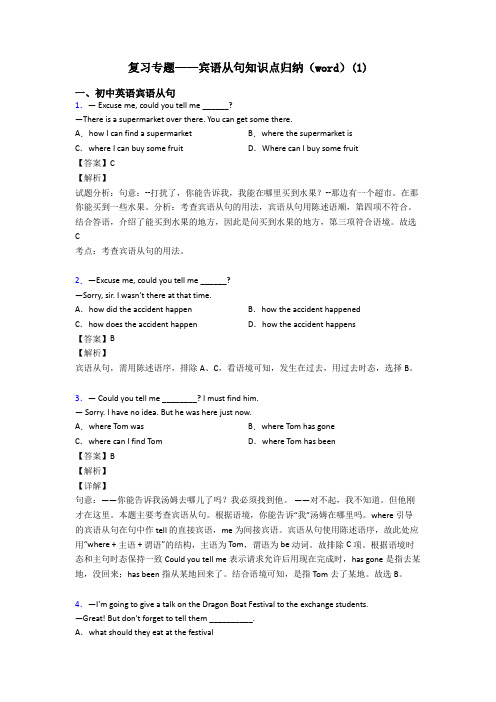
复习专题——宾语从句知识点归纳(word)(1)一、初中英语宾语从句1.— Excuse me, could you tell me ______?—There is a supermarket over there. You can get some there.A.how I can find a supermarket B.where the supermarket isC.where I can buy some fruit D.Where can I buy some fruit【答案】C【解析】试题分析:句意:--打扰了,你能告诉我,我能在哪里买到水果?--那边有一个超市。
在那你能买到一些水果。
分析:考查宾语从句的用法,宾语从句用陈述语顺,第四项不符合。
结合答语,介绍了能买到水果的地方,因此是问买到水果的地方,第三项符合语境。
故选C考点:考查宾语从句的用法。
2.—Excuse me, could you tell me ______?—Sorry, sir. I wasn’t there at that time.A.how did the accident happen B.how the accident happenedC.how does the accident happen D.how the accident happens【答案】B【解析】宾语从句,需用陈述语序,排除A、C,看语境可知,发生在过去,用过去时态,选择B。
3.— Could you tell me ________? I must find him.— Sorry. I have no idea. But he was here just now.A.where Tom was B.where Tom has goneC.where can I find Tom D.where Tom has been【答案】B【解析】【详解】句意:——你能告诉我汤姆去哪儿了吗?我必须找到他。
(完整版)初中英语从句汇总

在英语中,主要有三大从句,即名词性从句(包括主语从句,宾语从句,表语从句,同位语从句)、形容词性从句(即定语从句)、副词性从句(即状语从句,包括时间、条件、结果、目的、原因、让步、地点、方式等)。
以下是一些基本的从句的语法知识点A、定语从句专项讲解一、定语从句概念定语从句(attributive clause),顾名思义,就是一个句子作定语从属于主句。
定语一般是由形容词充当,所以定语从句又称作形容词从句。
另外,定语从句是由关系代词或关系副词引导的,故又称作关系从句。
定语从句一般放在它所修饰的名词或代词之后,这种名词或代词被称作先行词。
请看示例:The woman who lives next door is a teacher.1.先行词与关系词先行词就是被定语从句修饰的名词、代词等,它总是出现在定语从句的前面。
关系词指用来引导定语从句的词,分为关系代词和关系副词,关系代词在定语从句中作主语、宾语、表语、定语等,关系副词在定语从句中作状语。
1)关系代词2)关系副词2.如何选择关系词1)判断哪一部分是先行词,先行词指人、物、时间还是原因The book which/that I left here just now is gone. 我刚才放在这里的书不见了。
(the book 是先行词,指物)I'll forever treasure the days which/that we spent on the seashore. 我将永远珍惜咱们在海滨一起度过的那些日子。
(the days, 指时间)2)确定关系词。
既要考虑先行词,又要考虑关系词在从句中充当的成分。
比较: I'll forever treasure the days which/that we spent on the seashore.我将永远珍惜咱们在海滨度过的那些日子。
(先行词是 the days,指时间,在定语从句中作 spent 的宾语,因此选择关系代词 which 或that)I'll forever treasure the days when we played on the seashore.我将永远珍惜我们在海滨玩耍的那些日子。
初中英语状语从句知识点总结
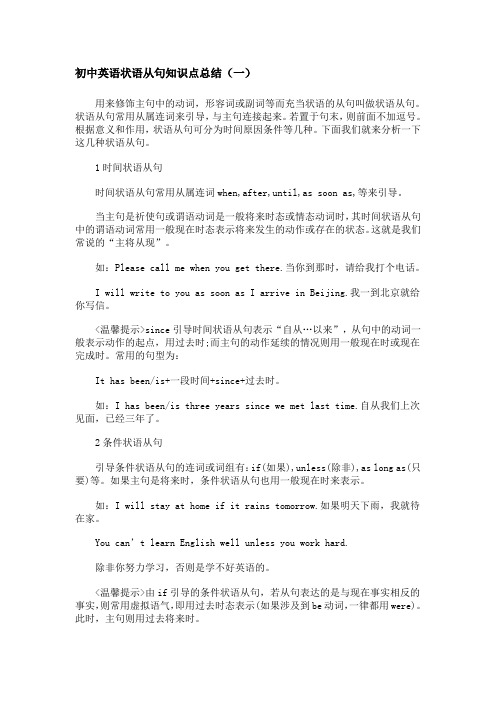
初中英语状语从句知识点总结(一)用来修饰主句中的动词,形容词或副词等而充当状语的从句叫做状语从句。
状语从句常用从属连词来引导,与主句连接起来。
若置于句末,则前面不加逗号。
根据意义和作用,状语从句可分为时间原因条件等几种。
下面我们就来分析一下这几种状语从句。
1时间状语从句时间状语从句常用从属连词when,after,until,as soon as,等来引导。
当主句是祈使句或谓语动词是一般将来时态或情态动词时,其时间状语从句中的谓语动词常用一般现在时态表示将来发生的动作或存在的状态。
这就是我们常说的“主将从现”。
如:Please call me when you get there.当你到那时,请给我打个电话。
I will write to you as soon as I arrive in Beijing.我一到北京就给你写信。
<温馨提示>since引导时间状语从句表示“自从…以来”,从句中的动词一般表示动作的起点,用过去时;而主句的动作延续的情况则用一般现在时或现在完成时。
常用的句型为:It has been/is+一段时间+since+过去时。
如:I has been/is three years since we met last time.自从我们上次见面,已经三年了。
2条件状语从句引导条件状语从句的连词或词组有:if(如果),unless(除非),as long as(只要)等。
如果主句是将来时,条件状语从句也用一般现在时来表示。
如:I will stay at home if it rains tomorrow.如果明天下雨,我就待在家。
You can’t learn English well unless you wo rk hard.除非你努力学习,否则是学不好英语的。
<温馨提示>由if引导的条件状语从句,若从句表达的是与现在事实相反的事实,则常用虚拟语气,即用过去时态表示(如果涉及到be动词,一律都用were)。
初中英语知识点总结定语从句
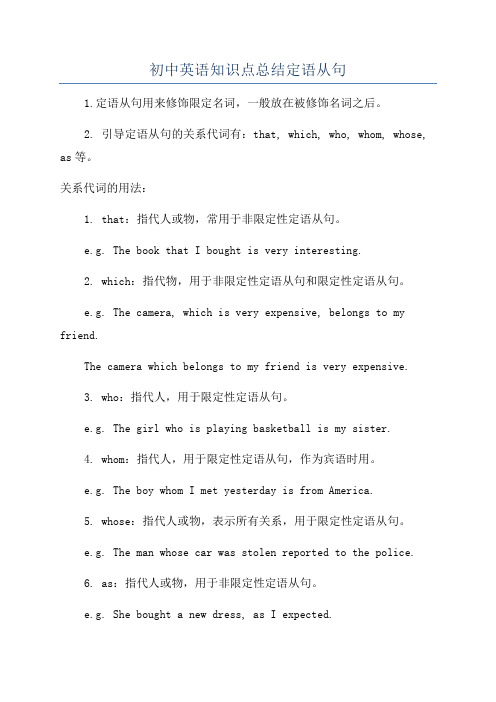
初中英语知识点总结定语从句1.定语从句用来修饰限定名词,一般放在被修饰名词之后。
2. 引导定语从句的关系代词有:that, which, who, whom, whose, as等。
关系代词的用法:1. that:指代人或物,常用于非限定性定语从句。
e.g. The book that I bought is very interesting.2. which:指代物,用于非限定性定语从句和限定性定语从句。
e.g. The camera, which is very expensive, belongs to my friend.The camera which belongs to my friend is very expensive.3. who:指代人,用于限定性定语从句。
e.g. The girl who is playing basketball is my sister.4. whom:指代人,用于限定性定语从句,作为宾语时用。
e.g. The boy whom I met yesterday is from America.5. whose:指代人或物,表示所有关系,用于限定性定语从句。
e.g. The man whose car was stolen reported to the police.6. as:指代人或物,用于非限定性定语从句。
e.g. She bought a new dress, as I expected.注意事项:1.关系代词在定语从句中充当主语时,可以省略,但在宾语位置不能省略。
e.g. I know the boy who/that broke the window.The girl (who/whom/that/which) I met yesterday is my classmate.2. 关系代词在宾语位置时,如果是指人,可以用"whom"来代替"who"。
(完整版)初中英语从句时态

1. 宾语从句:1 . 主句假设是一般现在时, 从句根据实际情况用适当时态.He says 〔that〕 he will have a walk soon.The teacher asks who is the cleverest in the school.I want to know who came here late this morning.2 .主句假设是一般过去时,从句也要用过去时.He wondered if I would come. She told me that her son had got well.She said that she liked watching TV. We thought Jim was wrong.3 .无论主句是何时态,从句假设表客观真理,要用一般现在时.Mr. Li said the moon is smaller than the earth.4 宾语从句无论有何引导词,都要用陈述句语序.Could you tell me when you will get back to Wuhan?〔不是will you 〕Do you know which sweater she is wearing? 〔不是is she〕2.状语从句:1 主句假设是一般将来时、祈使句或含不表过去的情态动词等,那么if〔如果〕,unless〔除非〕,when〔当•…的时候〕,as soon as「…就•••〕, before, after, until, till, as〔当••的时候〕所引导的状语从句用一般现在时.You may take a rest when you finish doing your work.I will call you up if I leave for Shanghai next week.Wait for your brother at the bus station until he arrives.2 而主句假设是一般过去时,从句也要用过去时,如:I would give the money to the charity if I had a million dollars.When he got to the park, his classmates had left.My son ran towards me as soon as he saw me on the street.3 .定语从句:关系代词who 只指人, which 只指物. that既可指人又可指物. whose 后必须跟有名词,既指人,也可指物.关系词作主语时,不可省略, 作宾语时可省略. whom只指人, 只作宾语. 关系副词where 指“在那里〞, when 指“在那时〞.She is a girl who/that is beautiful and kind-hearted.She is a girl (who/whom/that) I know very well.That boy whosehair is very long is my brother. ( 所属)The girl whois tall is my sister. / I own a bike whoseprice is high.I bought a watch (which/that) I paid 100 yuan for. (指物)I prefer a place which/thatis clean and quiet.I prefer a place whereI can live a quiet life. (在这儿)I shall never forget the day whena boy helped me find my dog.4 .wish 和hope:1wish 可接to do sth. /sb to do sth. /that从句.I wish to spend my summer holiday in Qingdao.I wish youto join my party this Sunday.I wish (that) I could be a scientist.2hope 接to do sth. 或that 从句. 但不接sb to do sth.I hope to receive a letter from you some day.I hope 〔that〕 everything goes well. /I hope you will get well soon.5 .thanks for 和thanks to: Thanks for your helping me with the work.〔表达对对方为自己做了某事的感谢, 后无补充的结果. 〕Thanks to your suggestion, I didn ’ t make such mistakes.〔表达感谢由于某方所做的有利的事,出现了后面的结果. 〕6 .感官动词用法之一:see, hear, listen to, watch, notice,feel 等词,后接宾语,再接动词原形/ 动词ing, 分别表示全过程和正在进行.句中有频率词时,以上的词也常跟动词原形.I heard someone knocking at the door when I fell asleep.〔正进行〕I heard someone knock at the door three times. 听的是全〔过程〕I often watch my classmates play volleyball after school.〔频率词〕假设以上词用于被动语态, 后面原有动词原形改为带to 不定式:We saw him go into the restaurant with his wife. fHe was seen to go into the restaurant with his wife.7 .感官动词用法之二:look, sound, smell, taste, feel 可当系动词,后接形容词. He looks . It sounds good. The flowerssmell beauti l. The sweets taste sweet. The silk feels soft. I felt tired.这些动词不用于被动语态. The sweets are tasted sweet.是错误的.注意:如果加介词like, 那么后不可接形容词, 而接名词或代词:He looks like his mother. That sounds like a good idea.It smells like a flower. It tastes like salt.8 .find 和think 局部用法: + 宾语+ 宾语补足语. 〔代替宾从〕宾补有以下情况:1.名词短语, John found his son a cleverboy.2. 形容词短语, Mrs. Smith thinks her husband kind of lazy.3.有时宾补后可接带to 不定式, I found it hard to fool thegirl.9.would like/want/feel like: 1 would like ,和want 类似:◊者B 可接名词短语:I would like/ want another three desks. ◊都可接带to 不定式:I would like/ want to go out for a walk.◊都可接sb,然后再跟带to不定式:I would like you to give me a hand.2 feel like: ◊后也可接名词短语:Do you feel like sometea?◊后假设接动词,须用动词ing形式:Do you feel like having a walk? I don ’ t feel like drinking【tfeeae.l like 常用于疑问句或否认句中.】10.词序易错的短语: 1 形容词修饰不定代词或不定副词,形容词在后面. Is there anything delicious in the fridge?Nothing serious. There is something wrong with the computer.I want to go somewhere warm.2 else修饰疑问词和不定代词、不定副词,也放在后面.What else can you see in the picture? Who else is in the room?Do you have anything else to say? Where else can you see it?3 enough 修饰形容词和副词, enough 放在后面.This sweater is cheap enough. Nemo is old enough to work.He ran fast enough to catch up with the dog.11 . 对“ 评价〞、“ 天气〞的提问之区别:1What do you thinkof …?=How do you like …你对••怎么看?"〔How ?句中有like,是动词.〕2What ' s the weather like in …? = How is the weather in …?的天气什么样?"〔What ••旬中有like,是介词“像〞. 〕12 .take, cost, pay, spend 区另fj:13 It + take + sb + some time + to do sth.It took us half an hour to cut down the tree.14 物+cost+sb+钱:The bag cost me thirty yuan. (cost, cost, cost)假设cost 后无sb, 那么译作“价钱是〞:The bag costs 30 Yuan.15 人+ pay +sb + 钱+ for sth: I paid the seller 200 Yuan for the bike. (pay, paid, paid). (pay 后所加内容可视具体情况取舍. )16 人+ spend + 时间/ 钱+ on sth / (in) doing sth.The girl spent two hours (in) searching the Internet.The girl always spends much money on her clothes.spend 有时可指“度过〞:spend holiday/ weekends/ winter17 .双宾结构:pass/ give/ teach/ offer/ lend/ send/ sell/ call/show/buy/ask/ tell/ build 等可加双宾结构.即后接sb + sth.其中pass, give, offer, lend, send, sell, show等可接sth + to sb.buy, build 等可接sth + for sb.另外,假设sth 是代词时,不用双宾结构.Please pass it to me.18 .局部词作连词与介词:〔连词接句子,介词接名词或代词〕Keep care l when you are listening to the teacher. 〔连词〕Keep care l when listening to the teacher. 〔介词〕类似的, while, than, before, after, as, since, until 等.如:I ’ ll wait until I hear from her. 〔连词〕I ’ ll wait until next Friday. 〔介词〕19 .动词ed与动词ing作形容词用法之一:1.动词ed作形容词:表示被动或已发生,常作定语. The boy named Peter ismy friend.那个叫做彼得的男孩是我的朋友. 划线局部起修饰作用,下同.He’ s eating fried chicken. 他在吃炸鸡. There is no timeleft.I have read a novel writtenby Lu Xun. 我读了一部鲁迅写的小说.He lives in a house builttwenty years ago.2. 动词ing 作形容词:表示正进行或功能,常作定语.the ing boy, a running bus, the rising sun, a bus running on the road, the boy ing in the corner 〔正进行〕a sitting room, the sleeping car, the bathing suit 〔功能〕16 .动词ed与动词ing作形容词用法之二:和心理感受有关,但ed 修饰人, ing 常修饰物. I felt surprised at his words.How exciting the film is! / I want to go to a place which is relaxing.17 .动词ing 和带to 不定式作主语:To be a teacher is my dream. Working hard brings you success.Taking care of our environment is very important.To plant trees makes me happy. 〔谓语用单数〕Reading books gives you knowledge. 〔谓语用单数〕Listening and writing are both difficult. 〔谓语用复数〕1.1 later / after / ago /before: llater 时间后〞结构:时间段+later常用于一般过去时. They went to Beijing five days later.〔later 单独在句尾,常用于将来时:I ’ ll see you later.〕2after “时间后〞结构:after+时间段,常用于一般过去时,和1 相同. They went to Beijing after five days.〔after 也可加句子:I’ ll send you an-me ail after I gethome. He found out the information after he hadsearched the Internet for thirty minutes.〕3ago 〞♦・时间前〞结构:时间段+ago,用于一般过去时. The Greens moved to Shanghai four weeks ago.〔since +时间段+ago,主句用现在完成时〕4before 单独放在句尾,常用现在完成时:“以前〞I have been to London before. He has seen the film before.〔假设是时间段+before,那么常用过去完成时,译为“…时间前〞:I had seen the film two weeks before. We had found out the answer to the problem an hour before.〕19 .四季:spring 春;summer 夏;autumn 秋;winter 冬; season季20 .月:January, 一月;February, 二月;March, 三月;April, 四月;May, 五月;June, 六月;July, 七月;August, 八月;September, 九月;October, 十月;November, 十一月;December, 十二月.21 . 星期:Sunday, 星期日;Monday, 星期一;Tuesday, 星期二;Wednesday, 星期三;Thursday, 星期四;Friday, 星期五;Saturday,星期六.Sunday为第一天,Saturday为最后一天.22 . “也〞:either, 用于否认句的末尾. also, 通常挨着动词, 少用于句尾. too, 通常在句尾, 前常有逗号. as well, 只用于句尾.注意:后三个词都不用于否认句.23 .带to 不定式用法之一:带to 不定式有逻辑宾语在前时, to 后动词用及物动词, 不及物时需加介词. The apples aretoo tall for the boy to reach. /The zoo is not a good place for animals to live in.24 .(a) little / (a) few: 1few , little 几乎没有;少“〞否认词.few 加可数名词复数, little 加不可数名词. 2a few 一些“ 〞肯定词,加可数名词复数; a little 一些;一点“ 〞也是肯定词,加不可数名词. 3 另外, 在too, very, so 等词后用few, little; 在only,just, still 等词后用 a few, a little. 而quite a few/ a little 译为“很多〞25 .及物动词+副词:put on/off/away/up/down/out; break off/down;turn on/off/up/down; get back; use up; give away/out/up/back; try out/on; ring/call up; let down; clean up/out; set up; think up; hand in/out; fix up; work out; ;dress up;pick up; help out;keep off/out/down cut down; write down; wake up( 叫醒);take off/away; sell out; look up/over; eat up; throwaway/off宾语是名词时,可放在中间或后边,是代词时只放在中间.26 .as ..... as用法:1 和--- i样…His room is as big asmine.He runs as fast as I /me 2as …as possible/sb can^可“台匕〞目匕…We went there as soon as possibl磁们尽可能快地去了那儿. Listen to the teacher as carefully you can. 3 有些短语有几个意思:as soon as和--- 样快;一…就•…;as much a/口…一样多;多达;as long as和-- 样长;长达;只要;as well as和---- i样好;和--- i样;as far as远达;就,…来说;27 .prefer 用法:prefer sth/doing sth to sth/doing sth 比起•… 更喜欢…prefer to do sth rather than do sth 宁愿•…也不愿…prefer to do sth / prefer doing sth 更喜欢做某事28 . some-, any-, every-用法:1some-某〜,一些〜工用于肯定的陈述句中. I have something to tell you. Maybesomebody has taken it. 假设用于疑问句中表示期待对方肯定的答复或表示请求或建议. Why not ask somebody to help you?Shall we give him something to eat? What about some milk?Could you please lend me some chairs? 2any-, 在疑问句中仍译为某〜,一些〜 " Do you have anything to say Is anybody in thehouse?在肯定句和否认句中译为任何〜" You may putthe box anywhere in the room. He is taller than any other student in the class. We don ’ t have anything to eat this morning. 3every-每〜〞,强调所有,既包括此也包括彼.Is everybody here?-No, Tom and Lucy have asked for leave. The glass was broken, and the water went everywhere.29 .动词时态和形式:八个时态:一般现在时、现在进行时〔am/is/are + v.ing〕、一般将来时〔will/shall/be going to+ 动词原形〕、一般过去时、过去进行时〔was/were +v.ing〕、现在完成时〔have/has + v. 过去分词〕、过去完成时〔had + v. 过去分词〕、过去将来时〔would + v. 原形〕六个形式:原形;过去式;过去分词;第三人称单数〔加s/es〕;现在分词〔v.ing〕;带to 不定式.30.if/whether 区别:if 如果〔引导条件状从〕 / 是否〔引导宾从〕whether 无论〔引导让步状从〕 / 是否〔引导宾从〕都译为是否"时,whether可接or not,也可接带to不定式.if那么不可.另外,if可接any-单词,常不接some-单词.If you have any water, please give me some.31.由于:because, 常是对why 的答复,语气最强.since,位置:Since …,….Since it ' s already late,Strgu now.for, 位置:…,for …语气最弱.I drove carefully, for it snowing.as有时也指由于工用法根本无限制.32.表推测:must, may, might, can, could, can ’tmust 〞定" 可能性最大,常用于肯定句.There is the door bell, it must be Tom.may / might也许〞一般用于肯定句, may比might可能性大.She is coming to us. She might be our new teacher.can / could可能" coulct匕can语气更委婉.但can多用于否认.You could be right, but I don ’ t think you are.The light in the office is off. The teacher can ’ t be therenow.33.so与such区别:so是副词,后跟形容词/副词,so tall/slowly …such 是形容词,后跟名词短语. such bad weather / good news…;such a beautiful girl / an important lesson / a heavy stone …;such kind boys / new desks / friendly people / amazing movies …;假设名词前形容词是many, much, few, little 时,不用such,而用so.so many flowers / much rain / few friends / little water …也常有“so / such•••tha向型,译为如此•…以致于...〞34.so的另两个用法:1so + be/情态动词/助动词+主语,也〞上下文所指不是同一个人或物. The twins are working, soam I.I will stay up tonight, and so will Peter.以及对话形式:A: I woke up late this morning. B: So did I.2so +主语+ be/情态动词/助动词,确实…是"上下文所指是同一个人或物. A: We have lunch at school. B: So you do.又如:A: Bruce can work out the problem. B: So he can.35.neither/nor 用法之一:neither/nor+ be/情态动词/助动词+主语“•也不〞上文是否认句.She didn t get well, nor did her brother.或对话形式:A: Jim hasn’ t had breakfast. B: Neither have1.36 .keep, make, get,have 用法:Ikeep + sb/sth doing sth 让…旦直做•♦" I ' m sorry for keeping you waiting so long. keep + doing sth 坚持做某事“〞2make + sb/sth do sth 让…做某事I ' ll try to make you understand what I mean. I feel sorry that I have made him wait for long.3get + sb/sth to do sth让••做某事.He got Peter to buy him a pen.4have + 宾语+ 动词原形/ing /过去分词Have him do it, please.让他做它吧.We had the machine working.我们让那台机器一直工作着. We had the machine repaired.我们让人修理了那台机器〔让那台机器被修理了〕.5 也都可接形容词:keep safe/busy, keep the doorclosed/open,make us happy, get the door closed, have everything ready.37 .used 短语:used to + 动原, 过去常常" He used to smoke.be used to译为被用来…〞,后接动原.It is used to cut things.be used to译为习惯于•••〞,后接动词ing或名词/代词.如:He’ s used to working late. / We are all used tofollowing others.be used for +目的〔名词或动词ing〕如:English is used for business./Knives are used for cutting things.38 . through/past/across: 都可作介词, “穿过〞前常有位移动词.He climbed through the window and saw what he could take away.He went past me without saying any words.He swam across the river. 【through,内部;past,旁边; across 外表.]位移动词+ past相当于动词pass;位移动词+across相当于cross.39 .the number of / a number of:前者〞•的数量〞;后者“许多的〞都跟可数名词复数.前者作主语,谓语用单数;后者作主语, 谓语用复数. The number of the trees is two thousand. 用单数is.A number of trees have been cut down用复数have.40 .延续性动词:How long , since, for, 〔以上见84〕until/till等所在肯定句中的主句谓语要用延续性动词.How long may I keep this novel? I ’ ve lived here since 2002.Let ’ s waitnutil he comes back.. 但否认句中可用短暂性动词:I haven ’ t seen you for a long time.41.all/each/both/none/either/neither:1All boys/All of the boys are from China. all 接可数复数, 谓语也用复数. All of the water is polluted. 假设接不可数, 谓语用单数.2Each boy/Each of the boys has a different bag. each 接名词单数或接of + 限定词+复数,后谓语都用单数.3Both of the twins are clever. 后面谓语用复数.4None of the students has/have been there before.none +of +限定词+复数, 谓语用单、复数都可.另见885-When shall we meet, Saturday or Sunday?-Either day is OK. / Either of the days is OK. 谓语用单数.6-When shall we meet, Saturday or Sunday?-Sorry, I have to look after my mother these two days. That is, neither time is OK. / neither of the days is OK. 谓语用单数.all/each/none分别指三者或更多中的都〞/每〔个〞/没“有一个〞. both/either/neither 两者中“都〞/任何一个“〞/没有一“个〞42 .计量表达法:数量+单位+形容词.The building is twenty meters tall./ The street is forty meters wide.The fish is five kilos heavy./ This baby is only six months old.假设计量表达的后面跟有名词,那么要用连字符,单位不用复数.They dug an eight-meter-deep hole. /. I bought a 10-kilo-heavy fish.It ’ s a piece o-fm2eter-thick ice. / They built a 50-meter-wide street.It ’ s a tw-moonth holiday. 〔此处计量中的形容词long 可省略. 〕43 . Must I/ May I / Need I 用诲.IMust I …我必须…吗?A: Must I finish the work? B: Yes, you must. / No, you needn’ t.2May I …?我可以…吗?A: May I go out for a walk now?B: Yes, you can. / No, you mustn ’ t/can ’ t.3Need I…?我有必要…吗?A: Need I clean the house? B: Yes, you must. / No, you needn’ t.44 .hundred/thousand/million/billion: 前有具体数字, 不加s 及of. 否那么加s, 加of. 如:thousands of trees; many millions of people.nine hundred people, ten thousand student算.但前假设有several,后常不力口s和of: several million pounds45 .反意疑问句〔QT〕局部用法/something, nothing, anything, everything 作主语, QT 主语用it.Something is wrong, isn ’ t it? / Nothing is cduiflfti, is it?46 t hink Lucy can do well in the exam, can ’ t she?I don ’ t think he will come here on time, will he?QT 要结合think 后的从句而定.3 祈使句的QT一般用will you? 而Let' s 用shall we?Get up now, will you? Don ’ t be noisy, will you?Be quiet, will you? Please don ’ t talk, will you?Let us do it now, will you? Let ’ s do it now, shall we?4There be 句型,QT 主语用there.There is a man working in the field, isn ’ tthere?There used to be a meeting on Friday, didn ’ tthere?There won’ t be a movie in the theatre, wltilhere?46.put on, wear, dress, in: 1put on, 穿上〞后接物. “ 表行为,是短暂动词. You should put on your coat when you leave.2wear, “穿,穿着〞后接物,表状态,是延续性动词. He always wears the yellow sweater in winter. /I like wearing beautiful clothes.3dress, 给“••穿衣〞后接人.You can dress yourself, baby.Lucy is dressing her little brother now.be dressed in后常接具有某种特征的衣物.The lady is dressed in a white skirt / white. 可直接加表颜色的词.4in, 穿着“ 〞后接具有某种特征的衣物,表状态,是介词,不可作谓语,可作状语. The woman in a white skirt is myteacher.Do you know the girl in a r ed coat? I ’ ve seen the boy in yellow.47.虚拟语气局部用法:在非真实条件句中要用虚拟语气, 即if 从句中用一般过去时, 而主句动词用would/should+动词原形,表示与现在相反的主观设想,也可以表示在说话人看来实现的可能性很小的情况. 〔注意:虚拟语气中的be动词都要用were.〕If there were no air, people would die. 〔与现在事实相反〕If I got rich, I would travel around the world. 〔可能性很小〕48.other/others/the other/the others/another:1 如果不特定指出哪一个, 是泛指, “ 另一个〞要用another,后加可数名词单数. If you are still thirsty, you may haveanother cup of tea.〔没特定指出哪——杯茶, 是泛指. cup是单数.〕another 也可+数字+可数复数:The meeting will last another two hours. / We need another six desks.2 如果只有两个或只有两局部,就给出了范围,其中另一个或另一局部是特指〔other前有the.〕,有如下用法:第一种,所说内容只有两个:Mrs. Green has two sons, one is interested in math, the other 〔one / son〕 is good at science. 【只有两个,用the other,不加s, 后面名词可省略. 】又如:This pair of shoes is strange.One is blue, yet the other is green. 这双鞋子很怪,一只蓝色, 而另一只绿色.第二种,只有两局部:此种情况下the other后接可数名词复数,或不接名词而只在the other后加s. Two fifths of thestudents in our class are boys, the other students are girls / the others are girls. Two children went, but the others stayed.〔其他孩子都留下了.〕3 如果没有显示出只有两局部, 未给出范围, 那么是泛指,不加the.Lei Feng liked helping other people / others.Have you any other questions?Alice didn ’ t like that dress, so she asked to see some others.4other 的另一用法:用比拟级的形式,表达最高级的含义.He is taller than any other boy in his class. 〔划线中boy 用单数〕=He is taller than all the other boys in his class. 〔划线中boy用复数)他比班里任何男孩都高〔他是班里男孩中最高的〕.49 .how long/how often/how soon/how far: 1how long 是对长度或时间段提问. How long is the river? - It ’ s 5,000 kilometers long.How long have you lived there? -For five months. / Since 2002.2how often 是对频率提问,如:never, sometimes, often, usually, always, once a week, twice a day, three times a year, every day 等.How often do you watch TV? -Every two days. / Twice a week.【假设只有次数,那么用how many times 提问:How many times do you watch TV a week? -Twice. / only once.】3how soon 是对“ in +时间段〞提问:-In a week./ In two How soon will you return to Beijing?days.4how far是对时间段's + walk/ride/drivegK计量表达提问.-How far is it from your home to the school?-Five minutes ’ walk. /An hour ’ s ride. /Thirteen minutes drive.或者说:It s about 20 kilometers 〔far〕 away.〔问和答复不同.〕50 .分数表达:二分之一: half a/an 或a half. 如:half an hour= a half hour 半小时It ' s half past sevenJ略冠词〕以下情况中, 分子〔基数词〕假设超过一, 分母〔序数词〕需加s:三分之一: a /one third 三分之二: two thirds四分之一: a/one fourth 或a/one quarter四分之三: three fourths 或three quarters.五分之一: a/one fifth 五分之二: two fifths 其它类推.假设分数所在of 短语作主语,谓语依of 后的名词而定:Two fifths of the students are on time. (指名词复数时,谓用复) Two fifths of the land is polluted. ( 指不可数时, 谓用单)51 .到达:1get to + 地点get to Shanghai/London/China接地点副词时,不带to. get there/home/here.2arrive in+ 大地点(Beijing/Zhengzhou) , arrive at+小地点(school/hospital), arrive 只作不及物动词. 所以也可单独用:Please ring me up when you arrive.reach 只作及物动词,后直接加地点:reachBeijing/England但常不说reach home/there/here.52 .感慨句:What + 名词短语+主语+谓语!What lazy boys (they are)! What hard work! What good news!What a good idea! What bad weather (it is)! What a pity!How +形容词/ 副词+ 主语+ 谓语!How hard the work is! How fast he runs! How rude you are!How carefully they are listening! How bad the weather is!53.because/ instead / out等与力口of 的区别:1because 后接句子, because of 接名词或代词.He didn ’ t come because he was ill. / because of his illness.2instead是副词,单独在句尾.instead of还要接名词或代词.We didn’ t have rice, we had noodles instead. / instead of it.3out副词,可单独用,但假设接地点,先加of.〔也可作介词,向…外〞,可不加of. 一般不要求掌握.〕He went out early. 或He went out of the house early.54 .too much, too many 与much too:much too过于工加形容词或副词原级. much toobig/slowly 等.too much “太多的〞,加不可数名词. too much work/rain 等.too many 太多的“,力口可数复数. too many books/people 等.55 . alone / lonely: 1alone, 单独一人;单独“〞不含感情色彩.可当形容词,但只在系动词后作表语:Jack is alone. 杰克是单身.The old woman is alone in the house. 那位老妇一个人在屋里.可当副词,修饰动词:She lives alone. 她独居.Can you move the stone alone? 你能单独搬动那块儿石头吗?Dick is walking on the beach alone. 狄克单独在海滩漫步.〔注意:不可说very alone. 但可说very much alone. 是特例〕2lonely, 孤独的;寂寞的“〞带有伤感色彩.只当形容词.可在系动词后作表语:The old man is lonely.这位老人是孤独的.He has many relatives, but he feels lonely. 他有很多亲戚,但感到孤独.〔lonely 和心理感受有关,而alone 和心理感受无关.〕也可在名词前作定语: a lonely person 一位孤独的人a lonely village 一个偏僻的村庄〔alone不可作定语〕56 .belong to 与be: This suit belongs to me /Lucy /my brother. 〔人〕This suit is mine /Lucy ’ s /my brother ’〔某物是某s /hers. 人的〕57.by 常见用法:1“通过〞I study English by memorizing grammar. You can know it by looking it up in a dictionary.He travels by bike.2“ 截止到〞Will you finish the task by tomorrow?The train had left by the time he got there.3“ 被〞This novel was written by Lu Xun.4“ 经过〞He passed by me without noticing me.5 在 ... 旁边“Sit by me. They are playing by the river.。
初中英语知识点总结从句
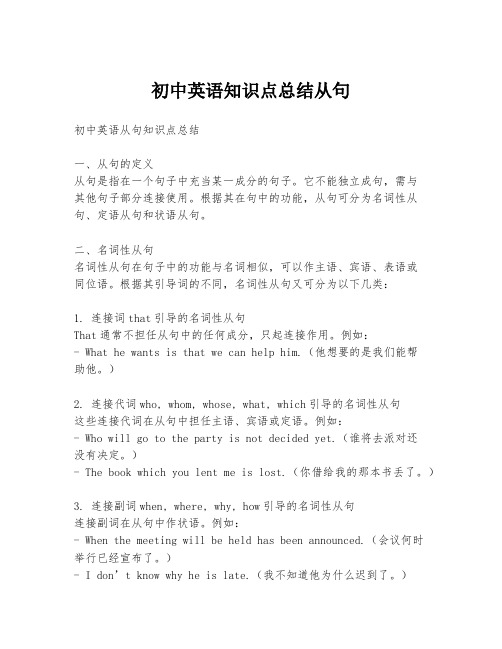
初中英语知识点总结从句初中英语从句知识点总结一、从句的定义从句是指在一个句子中充当某一成分的句子。
它不能独立成句,需与其他句子部分连接使用。
根据其在句中的功能,从句可分为名词性从句、定语从句和状语从句。
二、名词性从句名词性从句在句子中的功能与名词相似,可以作主语、宾语、表语或同位语。
根据其引导词的不同,名词性从句又可分为以下几类:1. 连接词that引导的名词性从句That通常不担任从句中的任何成分,只起连接作用。
例如:- What he wants is that we can help him.(他想要的是我们能帮助他。
)2. 连接代词who, whom, whose, what, which引导的名词性从句这些连接代词在从句中担任主语、宾语或定语。
例如:- Who will go to the party is not decided yet.(谁将去派对还没有决定。
)- The book which you lent me is lost.(你借给我的那本书丢了。
)3. 连接副词when, where, why, how引导的名词性从句连接副词在从句中作状语。
例如:- When the meeting will be held has been announced.(会议何时举行已经宣布了。
)- I don’t know why he is late.(我不知道他为什么迟到了。
)三、定语从句定语从句修饰名词或代词,通常紧跟在它所修饰的词之后。
引导定语从句的关系词有关系代词who, whom, whose, which, that和关系副词when, where, why, how。
1. 以关系代词引导的定语从句- The man who/that is standing there is my teacher.(站在那里的那个人是我的老师。
)- The book which/that you are reading is very interesting.(你正在读的那本书很有趣。
初中从句知识点总结讲解
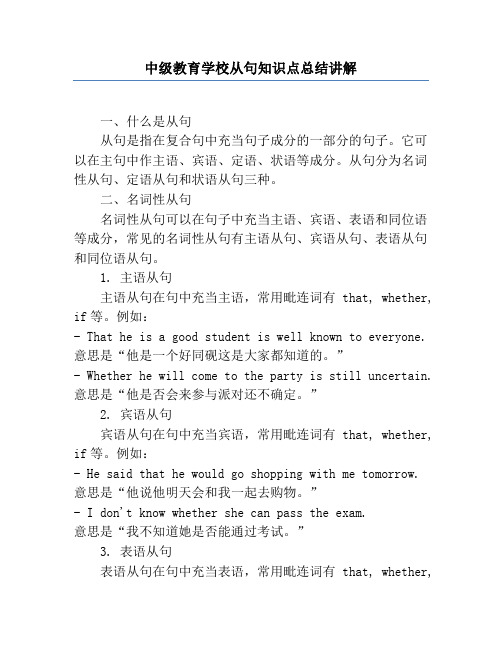
中级教育学校从句知识点总结讲解一、什么是从句从句是指在复合句中充当句子成分的一部分的句子。
它可以在主句中作主语、宾语、定语、状语等成分。
从句分为名词性从句、定语从句和状语从句三种。
二、名词性从句名词性从句可以在句子中充当主语、宾语、表语和同位语等成分,常见的名词性从句有主语从句、宾语从句、表语从句和同位语从句。
1. 主语从句主语从句在句中充当主语,常用毗连词有that, whether, if等。
例如:- That he is a good student is well known to everyone. 意思是“他是一个好同砚这是大家都知道的。
”- Whether he will come to the party is still uncertain. 意思是“他是否会来参与派对还不确定。
”2. 宾语从句宾语从句在句中充当宾语,常用毗连词有that, whether, if等。
例如:- He said that he would go shopping with me tomorrow. 意思是“他说他明天会和我一起去购物。
”- I don't know whether she can pass the exam.意思是“我不知道她是否能通过考试。
”3. 表语从句表语从句在句中充当表语,常用毗连词有that, whether,if等。
例如:- The fact is that he is a liar.意思是“事实是他是一个说谎者。
”- My concern is whether we can finish the project on time.意思是“我关注的是我们是否能按时完成项目。
”4. 同位语从句同位语从句在句中充当同位语,常用毗连词有that, whether, if等。
例如:- The news that he got the first prize made me happy. 意思是“他获得第一名的消息让我很兴奋。
初中英语:状语从句所有知识点归纳

第十七章状语从句知识点1状语从句的分类知识点2时间状语从句的用法知识点3地点状语从句和条件状语从句的用法知识点4原因状语从句和让步状语从句的用法知识点5比较状语从句和方式状语从句的用法知识点6目的状语从句和结果状语从句的用法知识详单知识点1状语从句的分类知识点2时间状语从句的用法知识点3地点状语从句和条件状语从句的用法知识点4原因状语从句和让步状语从句的用法知识点5比较状语从句和方式状语从句的用法知识点6目的状语从句和结果状语从句的用法考点突破考点1考查时间状语从句的用法1.(龙东中考)-Henry, please call us as soon as you _______ Hawaii.-OK. I'll do that, Mom.A. arrive inB. are arriving inC. will arrive at【解析】选择A as soon as结构意为“一……就……,”引导时间状讲从句,主句为祈使句,从句用一般现在时表示将来。
Hawaii 为大地点.因此用in.考点2考查地点状语从句的用法2.(扬州中考)-My friend has achieved his goal after years of hard work.--- Great.A·One tree can make a forest B. Where there is a will,there is a way C. Many hands make light work D. A friend in need is a friend indeed【解析】选B 第一个人阐述自己的朋友经过多年努力实现目标.,第二个人表示祝贺,同时,发表自己对此事的看法。
应该是“有志者,事竟成”.该句是where引导的地点状语从句。
考点3考查条件状语从句的用法3.(十堰中考)_________ deal with our problems, we can easily become unhappy.A. UntilB. IfC. UnlessD. Though【解析】选C。
初中英语从句知识点总结

初中英语从句知识点总结初中英语从句知识点总结初中英语从句知识点总结1从句分为定语从句,状语从句和名词从句三大类。
定语从句又分为限定性和非限定性从句两种,由关系代词或关系副词引导,修饰主句的某个成分。
状语从句分为时间、结果、让步、原因、条件及行为方式状语从句。
名词从句包括主语、宾语、表语和同位语从句及there be句型。
1.定语从句限定性定语从句中that可代表人和事,而which只代表事;二者在从句中作主语或宾语。
that作宾语时常可省略,which则不能,而且其后的“不及物动词+介词’’中的介词不能省略。
which作宾语时,先行词与which之间的介词不能省。
例如:1.The first doll that could say“mama”was invented in 1830.2.The second half of his voyage was by far the more dangerous part,during which he sailed round the Cape Horn.代表a11,anything,something,nothing,much等词时,用that而不用which,that作宾语可省略。
例如:1.I care anything that has something to do with it.2.You'd better do something he prefers to do to please him.3.That is the last time we met each other.4.I came across the woman you told me about yesterday.who和whom引导的从句用来修饰人,分别作从句的主语和宾语。
where是关系副词,用于表示地点的定语从句,而when用来表示时间。
whose是关系代词,修饰名词作定语。
初中英语知识点归纳名词性从句的构成及用法总结

初中英语知识点归纳名词性从句的构成及用法总结名词性从句是英语语法中的一个重要概念,可以在句子中充当名词的作用。
本文将从名词性从句的构成以及用法两个方面进行总结。
一、名词性从句的构成名词性从句由一个引导词和从句组成,通常可以通过以下几种引导词引导:1. 连接代词连接代词可引导主语从句、宾语从句和表语从句,常见的有:what、which、who、whom、whose、when、where、why等。
例如:- 主语从句:What she said is true.- 宾语从句:I don't know which book he wants to buy.- 表语从句:My question is who will go to the party.2. 连接副词连接副词通常引导状语从句,常见的有:how、when、where、why 等。
例如:- 时间状语从句:I will call you when I arrive.- 地点状语从句:We often go hiking where the air is fresh.- 原因状语从句:He couldn't attend the meeting because he was sick.3. 连接代词+ever连接代词+ever通常引导反义疑问句的陈述部分,例如:whoever、whatever、whichever、however等。
例如:- Whoever arrives first will get the prize.- You can eat whatever you like.二、名词性从句的用法名词性从句在句子中可以充当主语、宾语、表语和同位语的角色,下面将分别进行介绍。
1. 主语从句主语从句在句子中充当主语的作用,常见的连接词有:what、whether、which、who、whom、whose等。
例如:- What she said is important.- Whether we go or not doesn't matter.2. 宾语从句宾语从句在句子中充当宾语的作用,常见的连接词有:that、if、whether、what、which、who、whom、whose等。
初中英语知识点归纳宾语从句和主语从句

初中英语知识点归纳宾语从句和主语从句宾语从句和主语从句是英语语法中重要的知识点。
宾语从句用来作主句中动词的宾语,而主语从句则用来作主句的主语。
掌握这两种从句的正确使用方法对于学习英语的同学来说至关重要。
本文将对宾语从句和主语从句进行归纳总结,帮助大家更好地理解和掌握。
一、宾语从句宾语从句常常出现在下列动词后,包括:think(认为)、believe(相信)、know(知道)、say(说)、understand(理解)等。
例如:1. I think (that) he is a good student.我认为他是个好学生。
2. She said (that) she would come tomorrow.她说她明天会来。
3. Do you know (whether/if) he is busy?你知道他是否忙吗?在宾语从句中,引导词常常包括:that, if, whether等。
that在口语中常省略,但在写作中最好保留,而if和whether在表示“是否”的意思时可以互换使用。
宾语从句一般放在主句的动词后面,如果主句的时态是一般现在时或一般过去时,那么从句的时态不受影响。
但是如果主句的时态是一般将来时等,那么从句的时态需做相应的调整。
二、主语从句主语从句常常出现在下列句型中:1. It +be + (adj. / n.) + that ...例如:It is important that we learn English well.我们认为学好英语很重要。
2. What + be + (adj. / n.) + is ...例如:What matters is that you do your best.重要的是你尽力而为。
3. Wh- word + be + (adj. / n.) + is ...例如:Who is responsible for the accident is still uncertain.谁对这个事故负责仍然不确定。
初中英语定语从句知识点总结归纳
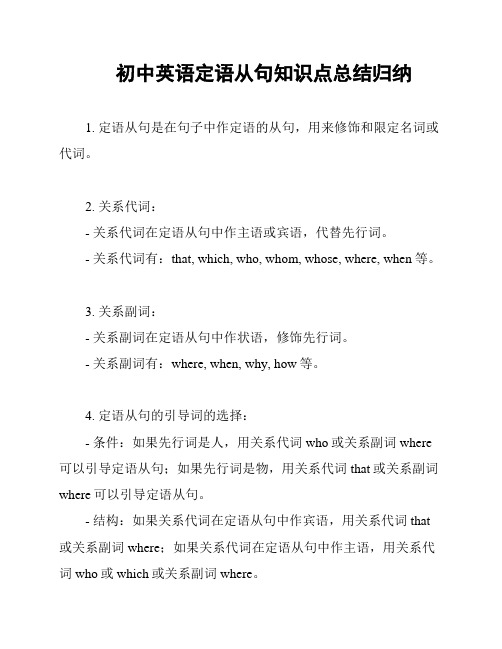
初中英语定语从句知识点总结归纳1. 定语从句是在句子中作定语的从句,用来修饰和限定名词或代词。
2. 关系代词:- 关系代词在定语从句中作主语或宾语,代替先行词。
- 关系代词有:that, which, who, whom, whose, where, when等。
3. 关系副词:- 关系副词在定语从句中作状语,修饰先行词。
- 关系副词有:where, when, why, how等。
4. 定语从句的引导词的选择:- 条件:如果先行词是人,用关系代词who或关系副词where 可以引导定语从句;如果先行词是物,用关系代词that或关系副词where可以引导定语从句。
- 结构:如果关系代词在定语从句中作宾语,用关系代词that 或关系副词where;如果关系代词在定语从句中作主语,用关系代词who或which或关系副词where。
- 所有格:如果先行词是人,用关系代词whose可以引导定语从句;如果先行词是物,用关系代词of which可以引导定语从句。
5. 定语从句的位置:- 当定语从句修饰的是句子中的主语时,定语从句放在主句后面;- 当定语从句修饰的是句子中的宾语时,定语从句放在主句后面;- 当定语从句修饰的是句子中的宾语补足语时,定语从句放在主句后面;- 当定语从句修饰的是句子中的表语时,定语从句放在主句后面;- 当定语从句修饰的是句子中的状语时,定语从句放在主句前面或主句后面。
6. 注意点:- 不可省略的情况:关系代词在定语从句中作主语时,不能省略;关系副词在定语从句中作状语时,不能省略。
- 可以省略的情况:当定语从句的主语和主句的主语一致时,可以省略定语从句中的关系代词that或关系副词where。
7. 示例:- The boy who is reading a book is my brother. (关系代词who在定语从句中作主语)- The pen that I bought yesterday is missing. (关系代词that在定语从句中作宾语)- This is the place where I was born. (关系副词where在定语从句中作状语)参考以上内容,可以帮助你更好地理解和运用初中英语中的定语从句知识点。
(完整版)初中英语从句知识点总结归纳
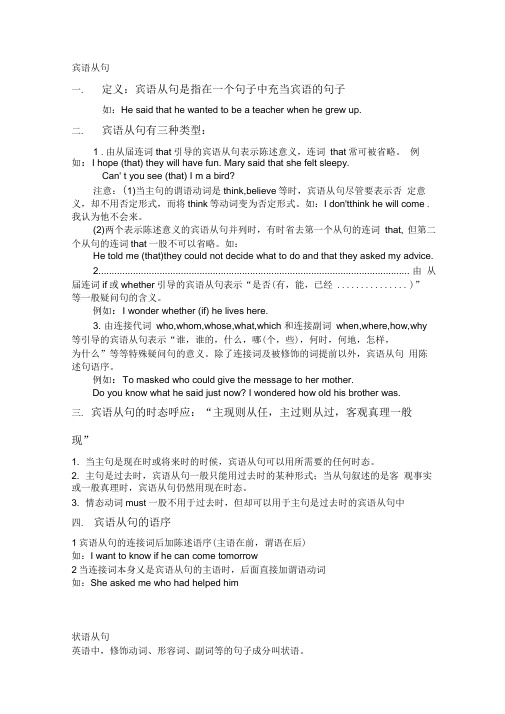
宾语从句一. 定义:宾语从句是指在一个句子中充当宾语的句子如:He said that he wanted to be a teacher when he grew up.二. 宾语从句有三种类型:1 .由从届连词that引导的宾语从句表示陈述意义,连词that常可被省略。
例如:I hope (that) they will have fun. Mary said that she felt sleepy.Can' t you see (that) I m a bird?注意:(1)当主句的谓语动词是think,believe等时,宾语从句尽管要表示否定意义,却不用否定形式,而将think等动词变为否定形式。
如:I don'tthink he will come .我认为他不会来。
(2)两个表示陈述意义的宾语从句并列时,有时省去第一个从句的连词that, 但第二个从句的连词that一股不可以省略。
如:He told me (that)they could not decide what to do and that they asked my advice.2..................................................................................................................... 由从届连词if或whether引导的宾语从句表示“是否(有,能,已经 ............... )” 等一般疑问句的含义。
例如:I wonder whether (if) he lives here.3. 由连接代词who,whom,whose,what,which 和连接副词when,where,how,why 等引导的宾语从句表示“谁,谁的,什么,哪(个,些),何时,何地,怎样,为什么”等等特殊疑问句的意义。
初中英语知识点归纳名词性从句的分类和引导词

初中英语知识点归纳名词性从句的分类和引导词名词性从句是英语语法中的一个重要部分,它在句子中起到名词的作用。
在初中英语中,名词性从句主要包括主语从句、宾语从句、表语从句和同位语从句。
本文将对这四种名词性从句的分类和引导词进行详细的归纳和总结。
一、主语从句主语从句在句中作主语,常常用来引导主语从句的引导词有:that, whether, who, whom, what, which, whoever, whatever, whichever等。
1. 引导词“that”该引导词常用于陈述句,如:- That he is a good student is well known to everyone.(他是个好学生这一点是众所周知的。
)- That we should protect the environment is of great importance.(保护环境非常重要。
)2. 引导词“whether”该引导词常用于一般疑问句和特殊疑问句中,如:- Whether he will come to the party or not is still uncertain.(他是否会来参加派对还不确定。
)- I don't know whether he is telling the truth.(我不知道他是否说的是真话。
)3. 引导词“who, whom”这两个引导词常用于主语从句中表示人,who作为主语,whom作为宾语,如:- Who will take care of the baby is not yet decided.(谁来照顾这个婴儿还没有确定。
)- Whom he loves is none of our business.(他爱谁与我们无关。
)4. 引导词“what”该引导词常用于主语从句中表示事物,如:- What makes him happy is playing basketball.(使他快乐的是打篮球。
初中英语知识点总结:宾语从句和状语从句

一、宾语从句知识点总结 在句子中起宾语作用的从句叫做宾语从句。
学习宾语从句要抓住三要素:引导词、语序和时态。
一、引导词 1.从句为陈述句,常选择引导词that,that引导宾语从句无意义,不充当句子成分常省略。
例句:He told us (that)they would help us through the whole work. 2.从句为一般疑问句,常选择引导词if或whether,表示“是否”。
在whether … or not 结构中不能用 if 替换。
例句:I don't know if there will be a bus any more. 3. 从句为特殊疑问句,常选择what,when,where,which,who,how等的疑问代词、副词作引导词。
例句:He didn't tell me when we should meet again. 二、判断时态情况: 1.主句是一般现在时,从句可以为各种时态。
2.主句是一般过去时,从句要用相应过去时态。
注意:从句描绘客观事实、真理、自然现象等,从句时态不受主句时态限制,仍用一般现在时。
例句:He answered that he was listening to me. Father told me that practice makes perfect . 三、宾语从句的语序要用陈述句语序 陈述句语序,就是主语在前,谓语动词在后。
错误:He is wondering when can he finish this difficult job. 正确:He is wondering when he can finish this difficult job. 注意:宾语从句的否定转移 主句的谓语动词是think,believe,imagine,suppose,consider,expect,fancy,guess等,并且主句的主语是第一人称而且为一般现在时,从句的否定词一般要转移到主句上来,其反义疑问句一般与宾语从句一致。
初中英语宾语从句知识点归纳
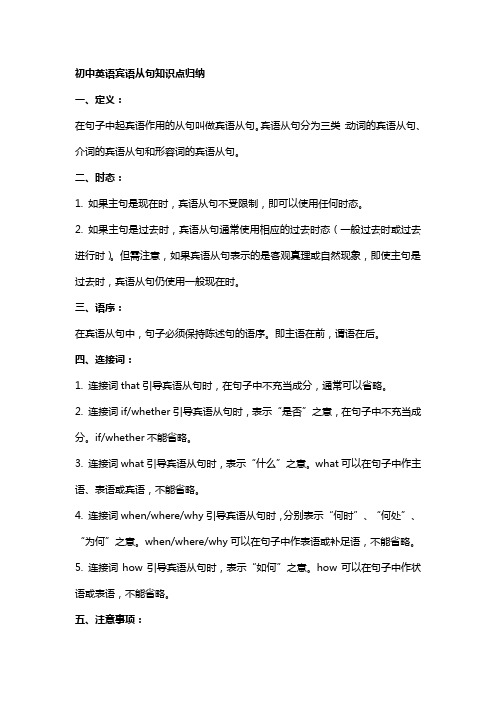
初中英语宾语从句知识点归纳一、定义:在句子中起宾语作用的从句叫做宾语从句。
宾语从句分为三类:动词的宾语从句、介词的宾语从句和形容词的宾语从句。
二、时态:1. 如果主句是现在时,宾语从句不受限制,即可以使用任何时态。
2. 如果主句是过去时,宾语从句通常使用相应的过去时态(一般过去时或过去进行时)。
但需注意,如果宾语从句表示的是客观真理或自然现象,即使主句是过去时,宾语从句仍使用一般现在时。
三、语序:在宾语从句中,句子必须保持陈述句的语序。
即主语在前,谓语在后。
四、连接词:1. 连接词that引导宾语从句时,在句子中不充当成分,通常可以省略。
2. 连接词if/whether引导宾语从句时,表示“是否”之意,在句子中不充当成分。
if/whether不能省略。
3. 连接词what引导宾语从句时,表示“什么”之意。
what可以在句子中作主语、表语或宾语,不能省略。
4. 连接词when/where/why引导宾语从句时,分别表示“何时”、“何处”、“为何”之意。
when/where/why可以在句子中作表语或补足语,不能省略。
5. 连接词how引导宾语从句时,表示“如何”之意。
how可以在句子中作状语或表语,不能省略。
五、注意事项:1. 当主句是将来时或表示意愿时,宾语从句要用一般现在时表将来。
例如:I will tell him when the meeting starts.(我会告诉他会议何时开始)。
2. 当宾语从句表示客观事实或普遍真理时,即使主句是过去时,宾语从句也用一般现在时。
例如:The teacher said that the earth is round.(老师说过地球是圆的)。
初中英语从句知识点总结归纳

初中英语从句知识点总结归纳从句是由一个主句和一个依附于主句的从句构成的句子成分,从句可以分为名词从句、形容词从句和副词从句。
以下是初中英语从句的知识点总结归纳:1.名词从句名词从句在句中担任名词的作用,可以作主语、宾语、表语、同位语等。
常见的连接词有:that, whether, if, what, who, which, when, where, why等。
2.形容词从句形容词从句在句中担任形容词的作用,用来修饰名词或代词。
常见的连接词有:that, who, which, whose, when等。
3.副词从句副词从句在句中作状语,修饰动词、形容词、副词或整个句子。
根据副词从句的不同功能,可以分为时间状语从句、地点状语从句、原因状语从句、目的状语从句、结果状语从句、条件状语从句、方式状语从句等。
常见的连接词有:- 时间状语从句:when, while, before, after, since, until, as soon as等。
- 地点状语从句:where, wherever等。
- 原因状语从句:because, since, as, now that等。
- 目的状语从句:so that, in order that等。
- 结果状语从句:so that, such that等。
- 条件状语从句:if, unless, in case, provided that等。
- 方式状语从句:as if, as though等。
需要注意的是,副词从句的连接词可以根据从句的功能和主句的需要进行选择和变化。
以上是初中英语从句的主要知识点总结归纳,掌握了这些知识点,可以更好地理解和运用从句。
同时,还需反复练习和积累,在实际应用中灵活运用。
初中英语知识归纳总结——宾语从句

初中英语知识归纳总结——宾语从句宾语从句知识概述宾语从句就是一个句子中另一个主句中作宾语,即宾语从句是用句子作宾语。
宾语从句的位置与陈述句结构中的宾语相同,它可作及物动词或介词的宾语。
常用的连词有that, if, whether, what, which, who, whom, when, where, how, why等。
教学重点1、宾语从句的结构(1) 由that引导的宾语从句that在从句中不充当任何句子成分,只起连接主句和从句的作用。
that不用翻译出来,在口语中常常省略,这种宾语从句常是陈述句。
The trouble is that we are short of money.(2) 由连词“if”或“whether”引导。
Whether或if在句中不充当任何句子成分,只起连接作用,但不能省略。
翻译为“是否”。
Do you know if Mr Smith is at home?(3) 由连接代词who, whom, whose, which, what或连接副词when, where, how, why等引导。
连接代词或连接副词位于从句的前面,起连接主句和从句的作用,从句用陈述句语序。
Do you know who broke the window?I don’t know when I shall finish.I wonder if the news is true.(4) 在某些形容词之后的从句有时也被看作宾语从句。
如afraid, sure, sorry, glad, worried, aware, confident, angry等。
They were angry that they had lost the chance.Can you tell me where the library is?I’m sorry that I’m late.2、宾语从句的时态一致(1) 主句是过去时,宾语从句要用过去时态;主句是现在时或将来时,宾语从句则该用什么时态就用什么时态。
- 1、下载文档前请自行甄别文档内容的完整性,平台不提供额外的编辑、内容补充、找答案等附加服务。
- 2、"仅部分预览"的文档,不可在线预览部分如存在完整性等问题,可反馈申请退款(可完整预览的文档不适用该条件!)。
- 3、如文档侵犯您的权益,请联系客服反馈,我们会尽快为您处理(人工客服工作时间:9:00-18:30)。
宾语从句一.定义:宾语从句是指在一个句子中充当宾语的句子如: He said that he wanted to be a teacher when he grew up.二.宾语从句有三种类型:1.由从属连词 that 引导的宾语从句表示陈述意义,连词 that 常可被省略。
例如: I hope (that) they will have fun. Mary said that she felt sleepy.Can’ t you see (that) ’I m a bird?注意:(1)当主句的谓语动词是 think,believe 等时,宾语从句尽管要表示否定意义,却不用否定形式,而将 think 等动词变为否定形式。
如:I don’t think hewill come. 我认为他不会来。
(2)两个表示陈述意义的宾语从句并列时,有时省去第一个从句的连词 that,但第二个从句的连词 that 一般不可以省略。
如:He told me (that)they could not decide what to do and that they asked my advice. 2.由从属连词 if 或 whether 引导的宾语从句表示“是否(有,能,已经)”等一般疑问句的含义。
例如: I wonder whether (if) he lives here.3.由连接代词 who,whom,whose,what,which 和连接副词 when,where,how,why 等引导的宾语从句表示“谁,谁的,什么,哪(个,些),何时,何地,怎样,为什么” 等等特殊疑问句的意义。
除了连接词及被修饰的词提前以外,宾语从句用陈述句语序。
例如: To masked who could give the message to her mother.Do you know what he said just now? I wondered how old his brother was.三.宾语从句的时态呼应:“主现则从任,主过则从过,客观真理一般现”1.当主句是现在时或将来时的时候,宾语从句可以用所需要的任何时态。
2.主句是过去时,宾语从句一般只能用过去时的某种形式;当从句叙述的是客观事实或一般真理时,宾语从句仍然用现在时态。
3.情态动词 must 一般不用于过去时,但却可以用于主句是过去时的宾语从句中。
四.宾语从句的语序1宾语从句的连接词后加陈述语序(主语在前,谓语在后)如: I want to know if he can come tomorrow2当连接词本身又是宾语从句的主语时,后面直接加谓语动词如: She asked me who had helped him状语从句英语中 ,修饰动词、形容词、副词等的句子成分叫状语。
状语的功用:状语说明地点、时间、原因、目的、结果、条件、方向、程度、方式和伴随状况等,根据状语的功能状语从句可分为:时间状语从句、原因状语从句、目的状语从句、结果状语从句、条件状语从句。
一.时间状语从句:在一个句子中作时间状语的句子。
时间状语的连接词:when(当时候)while(当时候) as(当时候) after (在以后)before(在以前)as soon as(一就)since(自从到现在)till /until (直到才) by the time(到为止)依旧是连接词后加陈述语序。
1.when 当的时候(一般情况下:主将从现)I will become a teacher when I grow up2.while 当时He visited a lot of places while he was traveling.3. as在的同时;一边一边He smiled as he stood up.4. after在之后He left the classroom after he had finished his homework the other day.5.before 在之前Mr. Brown had worked in a bank for a year before he came here.6.as soon as 一就 (一般情况下:主将从现 ) Webegan to work as soon as we got there.I will write to you as soon as I get home.7. since自以来到现在表示自过去的一个起点时间到目前 (说话时间 )为止的一段持续时间。
主句一般用现在完成时,从句用一般过去时。
Mr Green has taught in that school since he came to China three years ago还.可(以用since three years ago(自三年前以来)表示。
)作介词,本句从句还可以用短语:8till /until直到都可以作连词,连接时间状语,也可以作介词,与其它词构成介词短语,在句中作状语。
They walked till /until it was dark.Xiao Ming didn’ t leave home till / until his father came .back9.by the time 到为止 (所在句子的主句应用现在或过去完成时 ) Bythe time he gets there , his father has already gone.By the time I got to school, the class had already began.用法辨析: 1.when, while 和 as的区别When 引导的从句的谓语动词可以是延续性的动词,又可以是瞬时动词。
并且when 有时表示“就在那时”。
例如: When she came in, I stopped eating.她进来时,我在吃饭。
(瞬时动词 )When I lived in the countryside, I used to carry some water for him.当的住在农村时,我常常为他担水。
(延续性的动词)We were about to leave when he came in.我们就要离开,就在那时他进来了。
While引导的从句的谓语动作必须是延续性的,并强调主句和从句的动作同时发生(或者相对应)。
并且 while 有时还可以表示对比。
例如:While my wife was reading the newspaper, I was watching TV.I like playing football while you like playing basketball. 我喜欢踢足球,而你喜欢打篮球。
(对比)As 表示“一边一边” ,as 引导的动作是延续性的动作,一般用于主句和从句动作同时发生; as 也可以强调“一先一后。
例如: We always sing as we walk. 我们总是边走边唱。
( as 表示“一边一边”)As we was going out, it began to snow.当我们出门时,开始下雪了。
(as强调句中两个动作紧接着先后发生,而不强调开始下雪的特定时间)as when while 都表示主、从句动作同时发生,三者差异如下:as表示“一边。
一边"的意思when1、还可以表示从句动词的动作在主几句动词的动作"之前"或"之后"发生。
2、when=and then; at that moment 正(在那个时候 )3.常用于常见搭配中while1、用于时间较长时2、强调两个动作同时进行,并表示对比时有时这三个连词可以互换,有时不可以。
lt was raining hard when (as) I got there.我到那里时,正在下大雨。
( 动作同时发生, when 可换为 as, 但不能换为 while ,因为 get 是点动词 .)When I had read the article, he called me.我看完这篇文章之后,她给我打了电话。
( 从句动作发生在主句之前,注意时态表达,只能用 when )When I got to the cinema, the film had begun.(当)我到了电影院时,电影已经开演了。
(从句的动作发生在主句之后,只能用when,并要注意时态 )He was about to leave, when the telephone rang.他正要离开,忽然电话响了。
( 此时不能放在句首。
主句动词一般表达“正在”“即将” .while, as 不能代替She thought I was talking about her daughter, while, in fact, I was talking aboutmy daughter.他以为我在谈她女儿,然而,实际上在谈论我女儿。
(表转折,对比, when, as 都不能代替它 )While the alien was buying a souvenir, the girl called the police.外星人买纪念品时,那女孩给警察打了电话。
(表示主句,从句的动作同时发生,while 后引导的状语从句的动词必须是延续动词不能是点动词,因为它表示较长时间 )Mother was worried becauselittle Alice was ill, especially as (when/ while) father was away.妈妈担心,因为小爱丽丝病了,特别是他父亲不在家的时候。
(此时 as ,when, while可通用 )2.由 till 或 until 引导的时间状语从句。
till 和until 一般情况下两者可以互换,但是在强调句型中多用until 。
并且要注意的是:如果主句中的谓语动词是瞬时动词时,必须用否定形式;如果主句中的谓语动词是延续性动词时,用肯定或否定形式都可以,但表达的意思不同。
例如:I worked until he came back我.工作到他回来为止。
I didn't work until he came back.他回来我这才开始工作。
3.由 since 引导的时间状语从句。
since 引导的从句的谓语动词可以是延续性的动词,又可以是瞬时动词。
一般情况下,从句谓语动词用一般过去时,而主句的谓语动词用现在完成时,表述为:现在完成时 +since+一般过去时。
但在 It is +时间+ since 从句的句型中,主句多用一般现在时。
